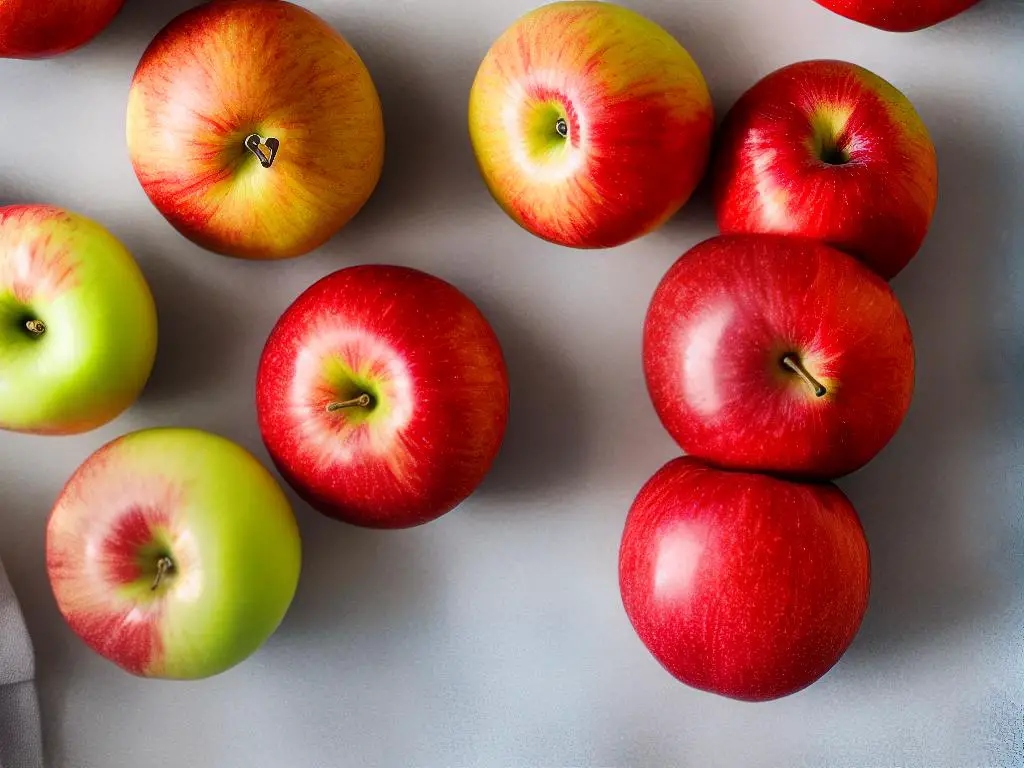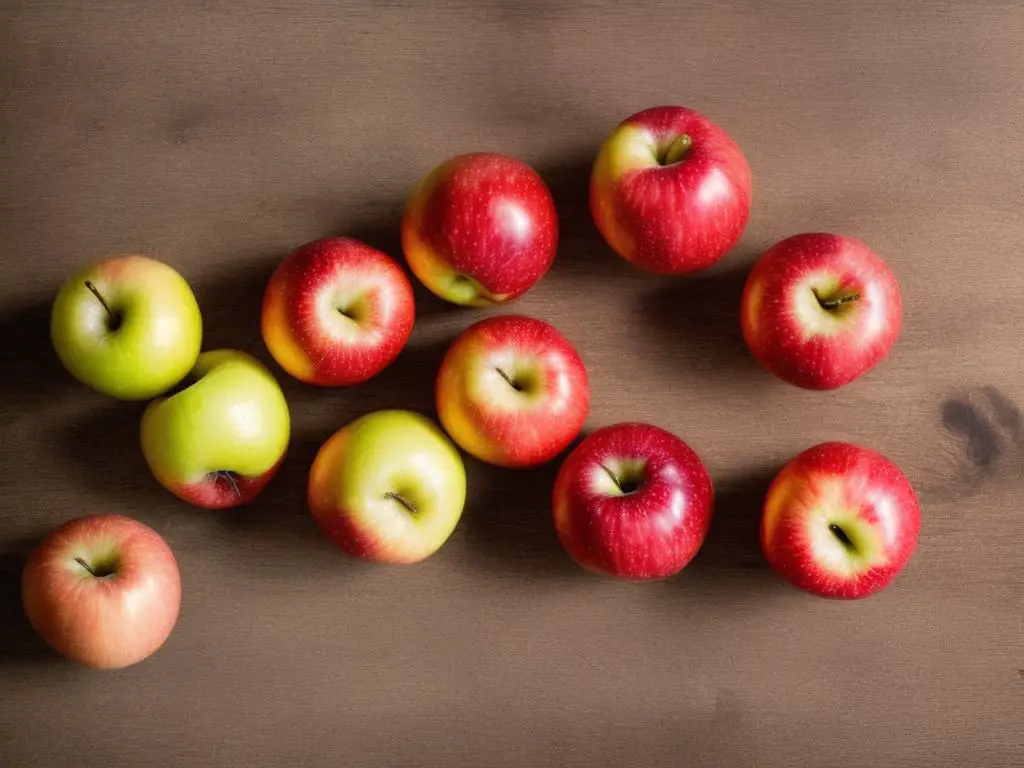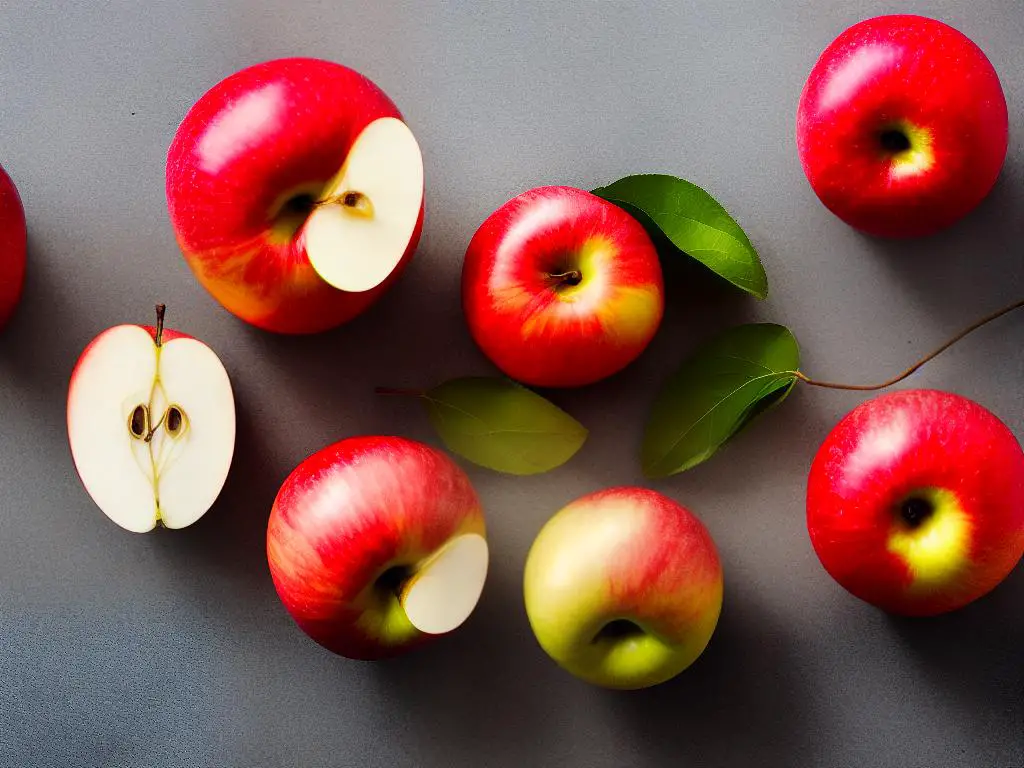As the leaves turn and the air cools, apple season takes center stage. The quintessential fruit of fall, apples come in a myriad of varieties, each with a distinct taste, texture, and a story of origin to tell. Among the pantheon of apples, the Crimson Crisp and Honeycrisp stand out, each offering a different palate experience with interesting backgrounds fertilized by centuries of cultivation. This exploration will take you through the alleys of their origin, the splendor of their tastes, and the richness of their health benefits, enlightening you on how these two apple varieties have become some of the most sought-after choices in markets and kitchens across the globe.
Origin and Cultivation: Crimson Crisp vs Honeycrisp
The Origin and History of Crimson Crisp Apples
Crimson Crisp apples, scientifically known as Malus Domestica ‘Co-op 39’, are relatively new to the apple world. This variety of apple was introduced by the Purdue, Rutgers, Illinois Co-op (PRI) in 2005. The Crimson Crisp is a cross between the two varieties ‘Golden Delicious’ and ‘PRI 610-2.’ The aim was to create an apple with excellent resistance to scab diseases, drought, and varying weather conditions which they fully achieved.
As the name suggests, these apples have a striking crimson skin that’s overlaid with broad, darker red stripes. Featuring a juicy texture and a sharp, richly aromatic flavor, the Crimson Crisp apple quickly became popular across the United States and Europe.
Cultivation of Crimson Crisp Apples
Crimson Crisp apple trees require a well-drained soil and a sunny, airy location for optimal growth. These trees flourish in moderate climates, with warm summers and cold winters, making them perfect for cultivation in the Midwestern and Eastern states. Keeping the trees properly pruned and watered are both key factors in ensuring the quality of the fruit.
These trees mature in late September to early October, offering medium to large sized apples. The fruit is firm, crisp and carries a boldly tart taste, which can be enjoyed fresh or used for cooking.
The Origin and History of Honeycrisp Apples
Honeycrisp apples, on the other hand, have a different story. Known scientifically as Malus Domestica ‘Honeycrisp’, this variety was developed at the University of Minnesota’s Horticultural Research Center. Released in 1991, the Honeycrisp is a cross between a Macoun and a Honeygold apple.
Honeycrisp apples are recognized by their yellow background overlaid with a mottled red blush. Their taste is uniquely balanced with a crisp texture and a distinct sweetness, contributing to their popularity.
Cultivation of Honeycrisp Apples
Honeycrisp apple trees thrive best in colder climates, making them a popular choice for the northern United States and Canada. They require fertile, well-drained soil and plenty of sunlight. These trees tend to grow quite large, so regular pruning is essential.
Honeycrisp trees bear fruit in mid to late September. The apples are usually large in size, and their unique flavor and shelf stability have made them a favorite for apple lovers everywhere. They are best eaten fresh, but they also store well and are commonly used in baking and for making cider.
Wrap-up
To wrap up, the journey of both Crimson Crisp and Honeycrisp apples from their origins to the present day is quite remarkable. Their unique flavors, ease of cultivation, and ability to thrive in various growing conditions have won them both favor with growers and fruit enthusiasts alike. Gaining a deeper understanding of the origins and cultivation techniques of these apple varieties serves as critical background knowledge for those intrigued by these two remarkable examples of apple diversity. Both of these apples, each special in its own way, beautifully showcase the variety and depth found in apple breeds across the globe.

Taste, Texture, and Culinary Uses: Crimson Crisp vs Honeycrisp
Comparing the Tastes of Crimson Crisp and Honeycrisp
The Honeycrisp apple, created by the University of Minnesota, stands out for its sweet, slightly tangy flavor. It takes its name from its honeyed sweetness and the crispiness of its bite. The balance of flavor in this apple has earned it a status as one of the premium apple varieties.
On the opposite spectrum, the Crimson Crisp is recognized for its tart and crisp texture. It’s a relatively recent addition to the apple family, developed by Purdue University. Noted for its spicy and tart taste, it presents a contrasting flavor profile to the sweeter Honeycrisp. The moniker ‘Crimson Crisp’ hints at not just its color, but also its crisp and densely packed flesh.
Texture of Crimson Crisp and Honeycrisp
Texture wise, as the names suggest, both apples are quite crisp. The Honeycrisp apple has a uniquely crunchy texture when bitten into, whereas the Crimson Crisp is firmer and denser. The extremely crisp texture of both apples helps to make them popular choices for fresh eating.
Culinary Uses of Crimson Crisp and Honeycrisp
Now to the fun part – the culinary uses of these two apple varieties. The Honeycrisp apple is excellent for both raw and cooked applications thanks to its sweet and tart balance. This makes them ideal for pies, tarts, and salads, and a popular choice for cider making.
Crimson Crisp apples, with their tart flavor and firm texture, are excellent for cooking as they retain their shape well. They make fantastic pies and tarts, where their brightness can cut through other rich flavors. Additionally, they are suitable for juicing and cider production.
Best Ways to Enjoy Crimson Crisp and Honeycrisp
Finding the best ways to enjoy these apple varieties largely depends on personal preference. However, since Honeycrisp apples have a more balanced sweet and tart flavor, they can be enjoyed on their own or paired with savory foods like cheese. On the other hand, the tart flavor of the Crimson Crisp, would make it a good match for sweeter accompaniments or ingredients in a dessert where its tartness can balance out sweetness.
Comparative Analysis
To establish a comparison, both the Honeycrisp and Crimson Crisp apples offer unique bursts of flavors. Both apple varieties tantalize the taste buds with their refreshing sharpness and distinctive crisp nature, yet differ vastly in terms of sweetness. The Honeycrisp variety is hailed for its honey-like sweetness, while the Crimson Crisp captivates with its appealing tartness. The diverse flavor profiles of these apples resonate well with diverse culinary applications and personal taste preferences. Whether you’re intending to bake a flavorful pie or seeking a healthy snack, both the Honeycrisp and the Crimson Crisp apples offer a perfect match for your taste requirements.

Nutritional and Health Benefits: Crimson Crisp vs Honeycrisp
Nutritional Characteristics of Crimson Crisp and Honeycrisp Apples
Apples are universally enjoyed for their health benefits and flavor diversity. Two varieties that stand out among the myriad of choices are the Crimson Crisp and Honeycrisp apples, which not only captivate with their delightful taste but also contribute towards maintaining good health. In this article, we will explore the nutritional constituents of these apples, focusing on their calorie, vitamin, and mineral content, fiber concentration, and respective bioactive compounds.
Crimson Crisp Apples
Developed for superior disease resistance and an exceptional taste, Crimson Crisp apples are relatively new to the market. A medium-sized Crimson Crisp apple supplies about 95 calories and 4 grams of dietary fiber, making up 16% of the daily fiber value. Additionally, it is a wonderful source of Vitamin C, providing approximately 14% of the daily intake.
Honeycrisp Apples
Captivating with their crunch and juicy sweetness, Honeycrisp apples contain about 80 calories per medium-sized apple, proving it as an excellent low-cal choice. Honeycrisp apples are also rich in dietary fiber, with one apple supplying roughly 5 grams. Similarly, Honeycrisp apples are a good source of Vitamin C, providing around 10% of the daily requirement.
Both Crimson Crisp and Honeycrisp apples include trace elements of other essential vitamins and minerals, such as potassium, Vitamin A, and Vitamin K. With no sodium, fat, cholesterol, or gluten, these apples serve as outstanding healthful snacks for all.
Health Benefits of Crimson Crisp and Honeycrisp Apples
Beyond their delightful taste and nutritional bounty, Crimson Crisp and Honeycrisp apples provide multiple health advantages. Their high fiber concentration aids in maintaining good digestive health and helps regulate cholesterol levels. Additionally, the comfort of feeling full after consuming these fiber-rich apples can aid in weight management.
Vitamin C found in these apples functions as a robust antioxidant, defending against deleterious free radicals and enhancing the immune system. Also, Vitamin C contributes to collagen synthesis, a protein indispensable for wound healing and maintaining sturdy cartilage, bones, and teeth.
Moreover, Crimson Crisp and Honeycrisp apples are blessed with bioactive compounds like flavonoids and phytonutrients which help in fending off chronic illnesses such as heart disease, diabetes, and specific cancers. These compounds also exhibit anti-inflammatory and antioxidant properties, further strengthening overall health.
Whether you appreciate the unique taste of Crimson Crisp or the refreshing crunch of Honeycrisp apples, both these apples offer substantial nutritional and health dividends. Incorporating these flavorful apples into your dietary regime can contribute to an enriched, healthful lifestyle. Therefore, the final decision might rest on individual taste preferences as both types of apples excel in their inherent health and nutritional attributes!

After traversing their historical lanes from their roots to our fruit baskets, diving into their flavorful profiles, and unfolding the bounty of health benefits they offer, we gain a renewed appreciation for these apple varieties – the Crimson Crisp and the Honeycrisp. They are far more than just pleasing additions to our palate. They’re capsules of history, symbols of horticultural achievement, bearers of health, and indeed, the fruits of human ingenuity and nature’s benevolence. As the seasons ebb and flow, let us embrace these delightful fruits, enjoy their unique flavors and textures, and nourish our bodies with their nutritional goodness.